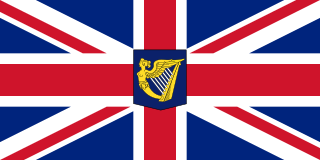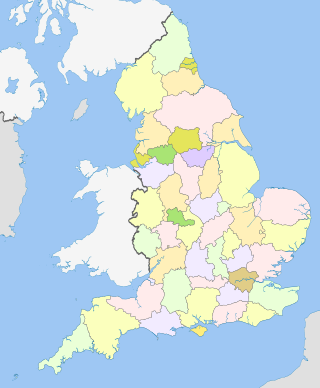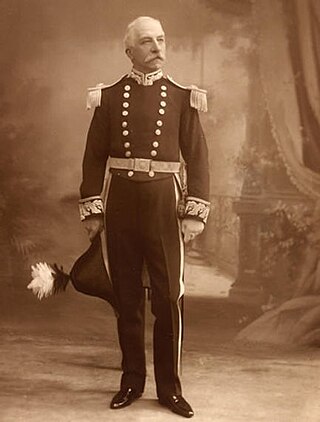Notes
- ↑ London Gazette
- ↑ Sainty, J. C. "Lieutenants and Lord-Lieutenants of Counties (Scotland) 1794-" . Retrieved 6 December 2008.[ dead link ]
Colonel [1] Gordon Guthrie Malcolm Bachelor was Lord Lieutenant of Kirkcudbright from 7 September 1975 to 16 November 1976. [2]

Lord Lieutenant of Ireland, or more formally Lieutenant General and General Governor of Ireland, was the title of the chief governor of Ireland from the Williamite Wars of 1690 until the Partition of Ireland in 1922. This spanned the Kingdom of Ireland (1541–1800) and the United Kingdom of Great Britain and Ireland (1801–1922). The office, under its various names, was often more generally known as the Viceroy, and his wife was known as the vicereine. The government of Ireland in practice was usually in the hands of the Lord Deputy up to the 17th century, and later of the Chief Secretary for Ireland.

A lord-lieutenant is the British monarch's personal representative in each lieutenancy area of the United Kingdom. Historically, each lieutenant was responsible for organising the county's militia. In 1871, the lieutenant's responsibility over the local militia was removed. However, it was not until 1921 that they formally lost the right to call upon able-bodied men to fight when needed.

Ceremonial counties, formally known as counties for the purposes of the lieutenancies, are areas of England to which lord-lieutenants are appointed. They are one of the two main legal definitions of the counties of England in modern usage, the other being the counties for the purposes of local government legislation. A lord-lieutenant is the monarch's representative in an area. Shrieval counties have the same boundaries and serve a similar purpose, being the areas to which high sheriffs are appointed. High sheriffs are the monarch's judicial representative in an area.
The lieutenancy areas of Scotland are the areas used for the ceremonial lord-lieutenants, the monarch's representatives, in Scotland. The lord-lieutenants' titles chosen by the monarch and his legal advisers are mainly based on placenames of the traditional counties of Scotland. In 1794, permanent lieutenancies were established by Royal Warrant. By the Militia Act 1797, the lieutenants appointed "for the Counties, Stewartries, Cities, and Places" were given powers to raise and command County Militia Units.
The order of precedence in Scotland was fixed by Royal Warrant in 1905. Amendments were made by further Warrants in 1912, 1952, 1958, 1999 to coincide with the establishment of the Scottish Parliament and Scottish Government and most recently in 2012.

In the United Kingdom, a deputy lieutenant is a Crown appointment and one of several deputies to the lord-lieutenant of a lieutenancy area – an English ceremonial county, Welsh preserved county, Scottish lieutenancy area, or Northern Irish county borough or county. Prior to the creation of the Irish Free State, all Irish counties had deputy lieutenants.
This is a list of people who have served as Lord Lieutenant of Lancashire. The Lord Lieutenant is the King's personal representative in each county of the United Kingdom. Historically the Lord Lieutenant was responsible for organising the county's militia, but it is today a largely ceremonial position, usually awarded to a retired notable, military officer, nobleman, or businessman in the county.
This is an incomplete list of people who have served as Lord Lieutenant for Powys. Prior to 1974, the Monarch was represented in the area by the Lord Lieutenant of Montgomeryshire, the Lord Lieutenant of Radnorshire and the Lord Lieutenant of Brecknockshire.
This is a list of people who have served as Lord Lieutenant of the County Palatine of Chester. Since 1689, all Lords Lieutenant have also been Custos Rotulorum of Cheshire.
This is a list of people who have served as Lord Lieutenant of Mid Glamorgan. Before the division of the county on 1 April 1974, the Monarch was represented by the Lord Lieutenant of Glamorgan.
The Lord-Lieutenant of Lincolnshire is the British monarch's personal representative in the county of Lincolnshire. Historically, the lord-lieutenant was responsible for organising the county's militia. In 1871, the lord-lieutenant's responsibility over the local militia was removed. However, it was not until 1921 that they formally lost the right to call upon able-bodied men to fight when needed. Since 1660, all lord-lieutenants have also been Custos Rotulorum of Lincolnshire.

The Lord-Lieutenant of Greater London is the personal representative of the monarch, currently King Charles III, in Greater London.
The position of Lord Lieutenant of North Yorkshire was created on 1 April 1974.

The Lord Lieutenant of Greater Manchester is the representative of the monarch, King Charles III in the metropolitan county of Greater Manchester in North West England. As Greater Manchester remains part of the Lancashire County Palatine, the Lord Lieutenant is appointed by the monarch in their capacity as Duke of Lancaster.
This is a list of people who served as Lord Lieutenant of Glamorgan. After 1729, all Lords Lieutenant were also Custos Rotulorum of Glamorgan. The post was abolished on 31 March 1974.
This is a list of people who have served as Lord Lieutenant of Pembrokeshire. After 1715, all Lord Lieutenants were also Custos Rotulorum of Pembrokeshire. The county corporate of Haverfordwest was included in this lieutenancy, except for the period from 1761 to 1931, when there was a separate Lord Lieutenant of Haverfordwest. On 31 March 1974, the post was replaced by that of Lord Lieutenant of Dyfed.
This is a list of those who have held the position of Lord Lieutenant of Cumbria. Cumbria was formed on 1 April 1974 by combining Cumberland and Westmorland, the area of Lancashire North of the Sands part of the Lonsdale Hundred and the former Sedbergh Rural District of the West Riding of Yorkshire.
This is an incomplete list of people who have served as Lord Lieutenant for Gwynedd. The office was created on 1 April 1974.
This is a list of the people who have served in the office of Lord Lieutenant of Dyfed, as created on 1 April 1974 in replacement of the former offices of Lord Lieutenant of Cardiganshire, Lord Lieutenant of Carmarthenshire, and Lord Lieutenant of Pembrokeshire.